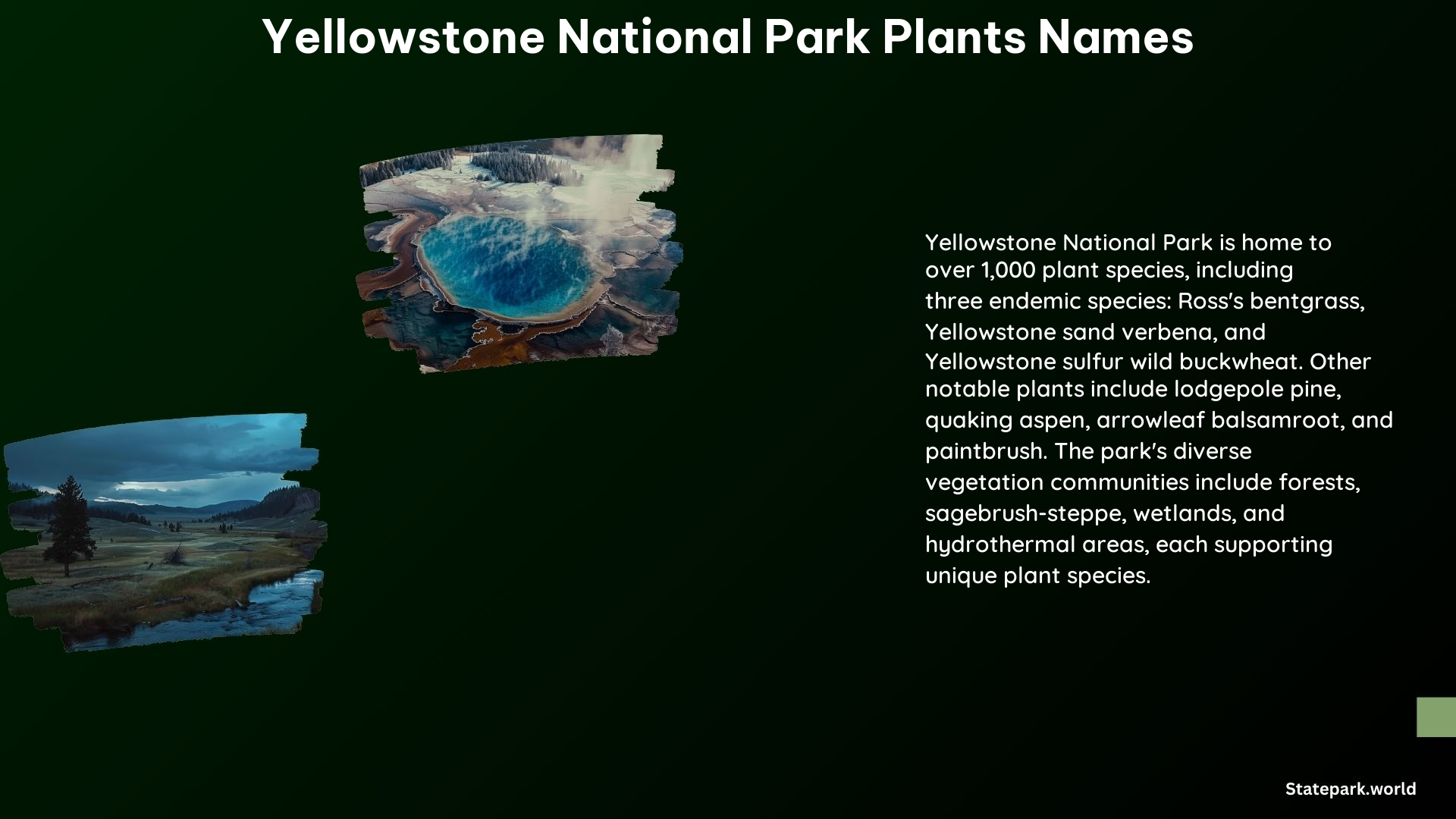Yellowstone National Park is home to a diverse array of plant species, including endemic, rare, and invasive plants. From the iconic lodgepole pine to the vibrant wildflowers that dot the landscape, the park’s vegetation is a testament to the region’s unique geology, climate, and history.
Endemic Plant Species
Yellowstone National Park is known for its endemic plant species, which are found nowhere else in the world. These rare and specialized plants have adapted to the park’s unique environmental conditions, making them a fascinating subject for botanists and nature enthusiasts alike.
Ross’s Bentgrass
This grass species is found only in the geyser basins of the Firehole River drainage and at the Shoshone Geyser Basin within Yellowstone National Park.
Yellowstone Sand Verbena
This plant species occurs along the shores of Yellowstone Lake, thriving in the park’s unique hydrothermal environment.
Yellowstone Sulphur Wild Buckwheat
This buckwheat species is found exclusively in the Firehole River drainage, adapted to the park’s geothermal features.
Wildflowers

Yellowstone National Park is a true haven for wildflower enthusiasts, with a diverse array of blooms that paint the landscape in vibrant hues throughout the growing season.
Two-lobe Larkspur
This beautiful spring flower, with its distinctive purple-blue petals, is a common sight in the park.
Bog Rein Orchis
Blooming in damp riverside meadows in June, this delicate orchid species is a true delight to spot.
Bog Candles
Similar to the Bog Rein Orchis, the Bog Candles can grow up to 75 flowers per stem, creating a stunning display.
Western Coralroot Orchid
This orchid species thrives in the sheltered pine woodlands of Yellowstone, adding a touch of elegance to the forest floor.
Arrowleaf Balsamroot
Known for its bright yellow flowers, this plant was an important food source for Native American groups in the region.
Paintbrush
These vibrant, eye-catching flowers can be found along roadsides and in open areas throughout the park.
Other Plant Species
Yellowstone National Park is home to a variety of other plant species, each contributing to the park’s unique ecosystem.
Lodgepole Pine
The most common tree in Yellowstone, the lodgepole pine was used by Native Americans for a variety of purposes, including as poles for their shelters.
Quaking Aspens
These trees are known for their stunning golden color in the fall, often growing in dense stands that add to the park’s natural beauty.
Marsh Marigold
Found in the park’s wet meadows and the Beartooth Mountains, this plant is a true indicator of the park’s diverse wetland habitats.
Arnica
This versatile plant can be found throughout Yellowstone National Park, adding pops of color to the landscape.
Shooting Star
The unique shape of this wildflower, with its distinctive petals, makes it a favorite among park visitors.
Vegetation Communities
Yellowstone National Park is home to a variety of distinct vegetation communities, each with its own unique characteristics and adaptations.
Forests
Covering approximately 80% of the park, Yellowstone’s forests include both higher- and lower-elevation species, creating a diverse and dynamic landscape.
Sagebrush-Steppe
This vegetation community is found in the northern range of the park, adapted to the drier, more open conditions.
Wetlands
Yellowstone’s wetlands include a wide range of habitats, from lakes and rivers to seeps, marshes, and hydrothermal pools, each supporting a unique array of plant life.
Hydrothermal Plant Communities
The park’s geothermal features have given rise to specialized plant communities adapted to the unique thermal conditions found in these areas.
Management and Conservation
Yellowstone National Park’s Vegetation & Resources Management Branch is responsible for inventorying, monitoring, managing, and researching the park’s plant communities. Efforts are made to restore native vegetation, especially in areas affected by invasive species.
Invasive Plants
While Yellowstone National Park is home to a wealth of native plant species, it also faces the challenge of managing invasive plants, such as the Dalmatian Toadflax, which can be found in disturbed areas like roadsides.
By understanding the diverse plant life found within Yellowstone National Park, visitors can gain a deeper appreciation for the park’s unique ecology and the importance of preserving its natural wonders for generations to come.
References:
– https://www.nps.gov/yell/learn/nature/plants.htm
– https://www.first-nature.com/worldsites/us-yellowstone.php
– https://wildflowersearch.org/search?oldstate=gmc%3A45.03%2C-110.71%3Bgms%3A12%3Blocation%3AYellowstone-National-Park–Gardiner%3Belev%3A5400%3Btitle%3AYellowstone-National-Park–Gardiner-Wildflowers%3B
– https://www.yellowstonenationalparklodges.com/connect/yellowstone-hot-spot/infographic-spot-these-plants-and-animals-in-yellowstone-national-park/
– https://www.nps.gov/yell/learn/nature/wildflowers.htm
